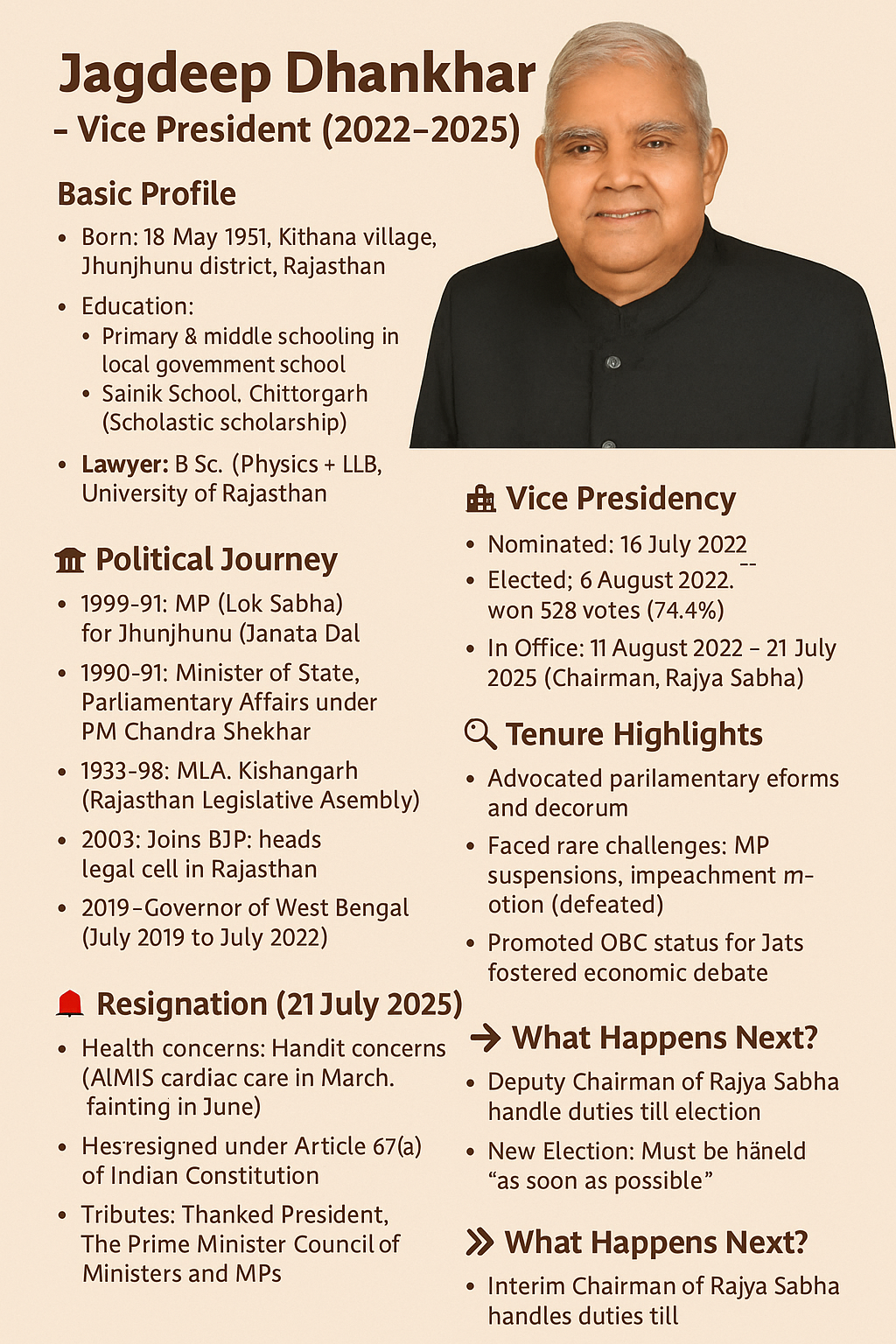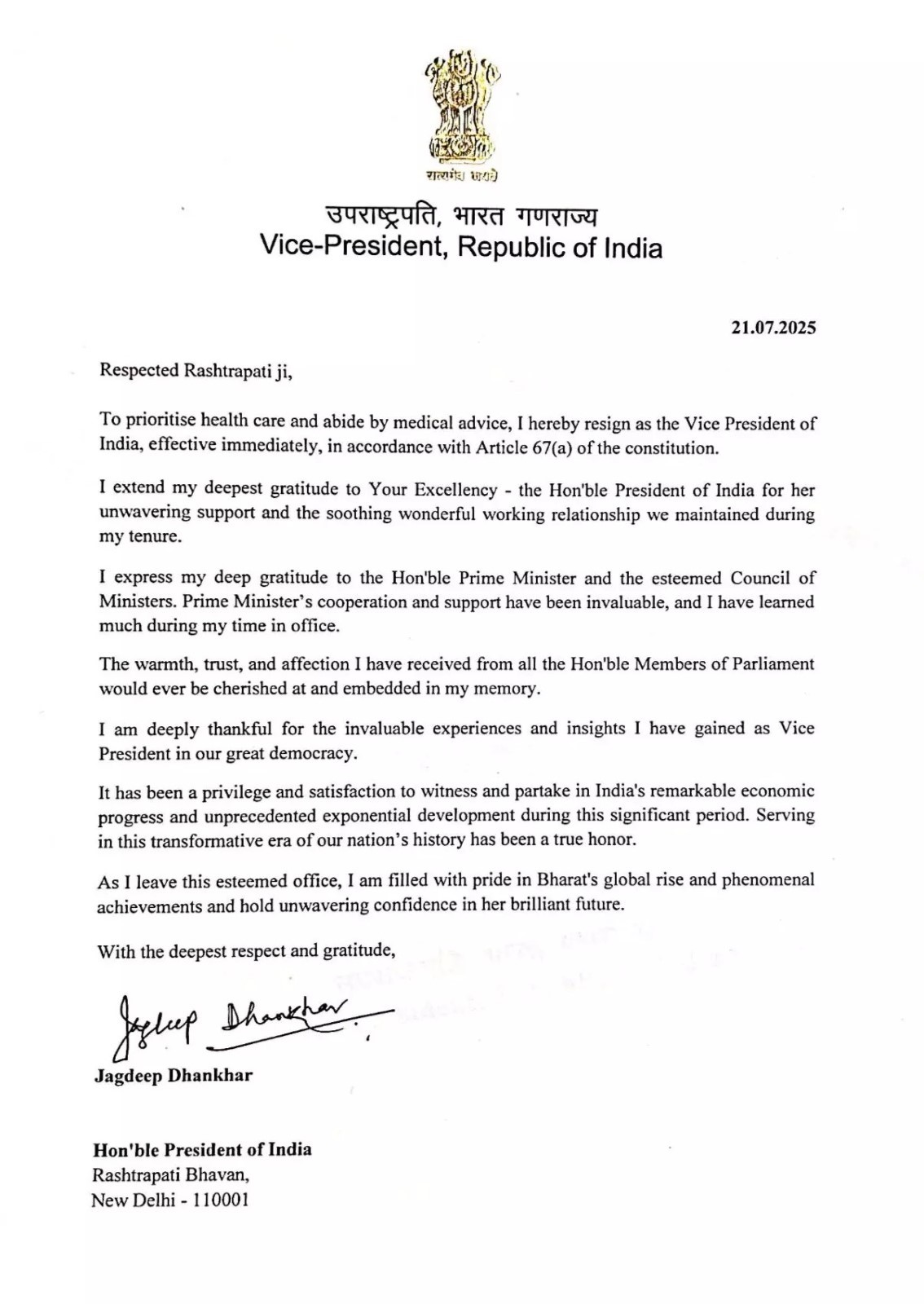Home / Current Affairs
Constitutional Law
Resignation of Vice President
« »22-Jul-2025
Why in News?
Jagdeep Dhankhar resigned as the Vice President of India on 21st July 2025, citing health concerns and medical advice. This resignation makes him only the third Vice President in Indian history to step down before completing his full term, submitting his resignation under Article 67(a) of the Constitution of India, 1950 (COI) to President Droupadi Murmu.
- The resignation is historically significant as it occurs mid-term, following his controversial tenure marked by strong advocacy for parliamentary supremacy and criticism of judicial overreach, particularly targeting the Supreme Court's Basic Structure Doctrine and collegium system.
Why Have the Vice Presidents of India Resigned?
|
S. No. |
Name of Vice President |
Date of Resignation |
Reason for Resignation |
Significance |
Result |
|
1 |
V. V. Giri |
20th July 1969 |
To contest the Presidential election as an independent candidate |
First Vice President to resign mid-term |
Elected President of India (1969–1974) |
|
2 |
R. Venkataraman |
July 1987 |
To contest Presidential elections |
Second VP to resign mid-term |
Elected President (1987–1992) |
|
3 |
Shankar Dayal Sharma |
24th July 1992 |
Resigned after being elected President |
Resigned to assume Presidency |
Served as President (1992–1997) |
|
4 |
Bhairon Singh Shekhawat |
21st July 2007 |
Defeated in Presidential election |
First to resign after losing Presidential race |
Continued in public life until passing in 2010 |
|
5 |
Jagdeep Dhankhar |
21st July 2025 |
Health concerns; based on medical advice |
Third VP to resign mid-term; first to resign for health reasons |
Resignation marks rare medical exit from office |
What Happens Next after Resignation of the Vice President?
- The Election Commission will announce Vice Presidential election schedule "as soon as possible" under Constitutional mandate, with ruling NDA coalition expected to secure comfortable victory given current parliamentary arithmetic.
- Rajya Sabha continues normal functioning under Deputy Chairman Harivansh Narayan Singh with full presiding powers, ensuring no constitutional vacuum or legislative disruption during interim period.
- New Vice President will serve complete five-year term from assumption date through electoral college voting by all MPs via secret ballot using proportional representation system.
- The presidential succession line remains intact with zero impact on executive functions, demonstrating the constitutional framework's robustness until a new VP takes oath and restores complete institutional normalcy.
What are the Constitution Provisions for Vice President?
Article 63 - Office of Vice President
- Establishes the constitutional office of Vice President of India.
- The second highest constitutional office in the country.
Article 64 - Ex-Officio Chairman of Rajya Sabha
- Vice President serves as ex-officio Chairman of the Council of States (Rajya Sabha).
- Cannot hold any other office of profit simultaneously.
- During presidential duties, cannot perform Chairman functions or receive Chairman's salary.
Article 65 - Acting as President
- Vice President acts as President during casual vacancies.
- Functions during the President's absence, illness, or other causes.
- Enjoys all presidential powers and immunities during such periods.
- Entitled presidential emoluments during acting capacity.
Article 66 - Election of Vice President
Clause (1) - Electoral College:
- Elected by members of both Houses of Parliament.
- Includes both elected and nominated members of Rajya Sabha and Lok Sabha.
- State legislatures do not participate (unlike presidential elections).
Clause (3) - Eligibility Criteria:
- Must be a citizen of India.
- Minimum age of 35 years.
- Qualified for election as Rajya Sabha member.
- Cannot hold any office of profit under Union/State governments.
- Must be registered as elector in any parliamentary constituency.
Article 67 - Term and Resignation
Clause (a) - Resignation Provision:
- Vice President may resign by writing under his hand addressed to the President.
- No specific format prescribed beyond written communication.
- Immediate effect upon submission to President.
Term of Office:
- Five-year term from date of assuming office.
- Continues in office until successor assumes charge.
- New elected VP serves full five-year term, not remainder of predecessor's term.
Article 69 - Oath of Office
- Vice President takes oath before President or appointed person.
- Must subscribe to oath before entering office.
- Constitutional requirement for assuming duties.
Election Process for New Vice President
Timeline and Authority
- No fixed constitutional deadline for conducting election.
- Requirement: Election to be held "as soon as possible".
- Election Commission announces schedule.
- Conducted under Presidential and Vice-Presidential Elections Act, 1952.
Voting Mechanism
- Location: Parliament House, New Delhi
- Method: Secret ballot using proportional representation with single transferable vote.
- Process: MPs rank candidates by preference order.
- Vote Value: Equal value for all MPs regardless of constituency size.
Quota Calculation
- Formula: (Total valid votes ÷ 2) + 1 (fractions ignored)
- Elimination Process: Candidate with lowest first preference votes eliminated.
- Transfer: Votes transferred based on second preferences.
- Victory: First candidate to cross quota declared elected.
Returning Officer
- Secretary General of either House of Parliament (by rotation).
- Appointed as per established convention.
Removal Provisions (Article 67)
Constitutional Process
- Resolution must pass in Rajya Sabha by majority of all members.
- Resolution must be "agreed to" by Lok Sabha.
- Minimum 14 days' notice required before moving resolution.
- Different from presidential impeachment process.
Historical Event
- No Vice President has ever been removed through this process.
- Process similar to removal of Lok Sabha Speaker.
- Constituent Assembly debates highlighted procedural clarity concerns.


